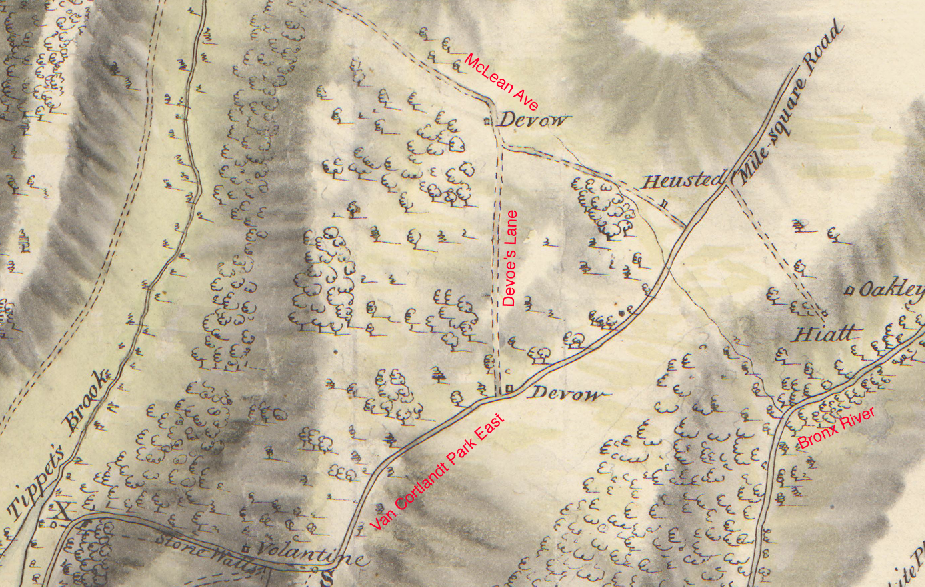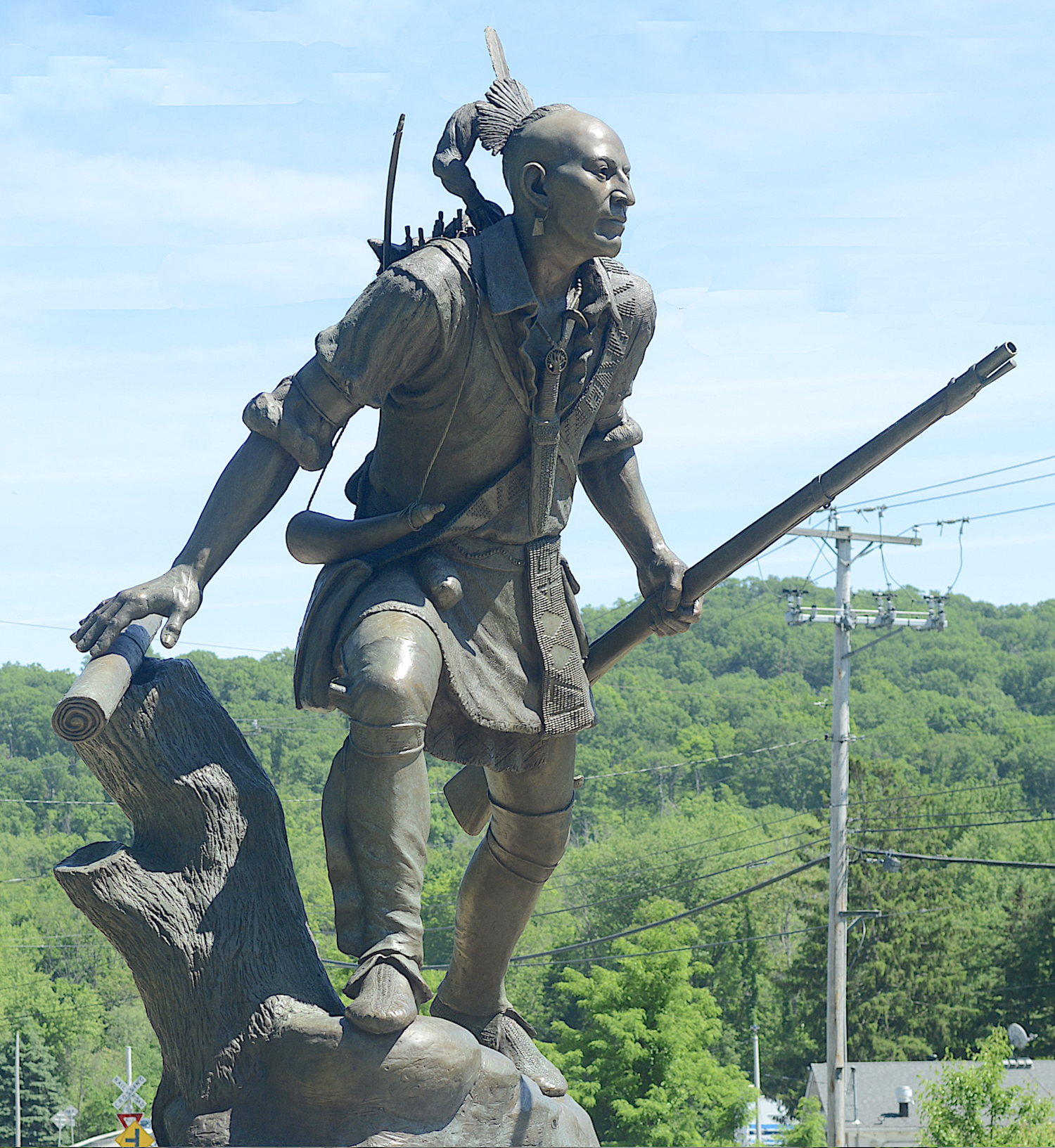Home › Forums › The American Revolution › Battle of Kingsbridge Memoirs (Stockbridge Militia Skirmish) McDonald Paper
- This topic has 4 replies, 4 voices, and was last updated 1 year, 5 months ago by
KeropianSculpture.
-
AuthorPosts
-
-
September 2, 2021 at 5:49 pm #2139
It was great to see a decent crowd of people at the Stockbridge Indian Memorial this week to honor the Native American militiamen that fought and died in our neighborhood in 1778. There are many good accounts of the skirmish to be found elsewhere such as this one.
But many accounts do not take advantage of the fact that residents of Westchester were interviewed in the 1840s to record local knowledge of the Revolution, including the “Battle of Kingsbridge.” Some of the interviewees were old enough to remember it while others shared stories that were passed down orally. These stories are known as the “McDonald Papers” and are housed at the New York Historical Society as well as the Westchester County Historical Society.
A man named Daniel Devoe gave an interview. The skirmish began on the Devoe family’s property.

Annotation of a clipping from this map. In the above map clipping, you see the house of Daniel Devoe fronting on the Mile Square Road (today’s Van Cortlandt Park East). The home of Frederick Devoe is to the north on today’s McLean Ave. They are connected by “Devoe’s lane,” which still partially exists in the form of a park trail. Below is Daniel Devoe’s interview:
Interview with Daniel DeVoe: August 26, 1844
The road which passes from the Mile Square Road [today’s Van Cortlandt Park East] west by my house was made after the Revolutionary war, before which it (my house) stood in the fields. My father and grandfather (John and Frederick Deveau) lived in it. John Deveau was my father. Daniel Deveau lived in the other house by the road where Mr. Brown the lame man lives, who is also a grandson of Daniel Deveau. When the Indians were ambuscaded in ’78, by Simcoe, they were chased by the Light Horse down the Ridge and across the fields covered with yellow weed (Johnswert) from the road near Browns into the woods below my house (Courtland’s woods). They passed in their flight between the two houses into the woods, and many threw away their muskets, which were French guns, for convenience of running. One Indian was offered his life if he would say “Long live King George!” but he shook his head and was killed. Our house was struck by bullets often during the fight. Emmerick [Col. Andreas Emmerich] was a very talkative, agreeable man–often visited my father–and was fond of being with the women to whom he made himself agreeable. He was more social than Simcoe who also visited my father often. Courtland’s house is one and a half miles from my house–Courtland’s woods extend to the road which connects the Deveau houses. Hunt’s Bridge [is] east of Yonkers.
There are three places called Valentine’s Hill, vizt. 1st, Dennis Valentines; 2nd a hill on the west side of the Bronx where Valentine lives; and 3rd the real Valentine’s Hill on the east of the Bronx.
There is plenty of interesting info here but one thing that strikes me are the stories of the officers fighting for the British–Andreas Emmerich and John Graves Simcoe. The local people knew these men well and opinions of them varied wildly.
In a follow-up interview Daniel Devoe said:
My grandfather, who owned the house in the fields in 1778 was Frederick Devoe, and the other house on the Mile Square Road was owned by Daniel Devoe. On the day of the Indian fight, Colonel Emmerick was fired at by an Indian near my grandfather’s (Frederick Devoe) house and narrowly escaped.
Other interviewees shared different information:
Interview with Augustus Cregier:
Tarleton charged an Indian at Deveau’s who fell flat down on the ground and tripped his horse, and then seized and was about to kill Tarleton when a Legion solder (named Murphy) came up and rescued him. Daniel Deveau lived by the road and Frederick Deveau in the fields. Three Indians were killed at Tippett’s Brook. The Battle was between Mile Square Road and Tippett brook across Courtland’s ridge which was east of Tippett’s brook. There are two ridges called Courtland’s, one east of and the other west of Tippett’s brook.
Interview with Joseph Odell:
At the ambuscade of Nimham, Colonel Emmerick was deliberately fired at by an Indian and narrowly escaped by ducking his head–the ball hitting his hat. The Indians passed my fathers down the Saw Mill River Road, the day before they were surprised and cut to pieces.
Interview with Dennis Valentine
The Stockbridge Indians were cut off in Courtland’s Locust Orchard, a little west of the Mile Square Road about half a mile southeast of Courtland’s house.
John Hopkins recalled:
The Stockbridge Indians passed my father’s which was the first house north of Smith’s Tavern. Steve Hunt then belonged to Emmerick’s and said that Emmerick exclaimed to the men after they had defeated the Indians: “Ah very fine men! Very fine men!” When the men dodged he said: “You mustn’t do so–It’s no use–what do you dodge for?”
Zipporah Davis (nee Miller of the Miller house):
A young son (almost a baby) of Nimham was killed by, I think, one of Meigs’s men, and the old chief was very anxious to have the murderer discovered and punished but this was not done. Nimham and his men lay for some time in the “calf pasture” near our house.
Interview with Hannah Miller:
The Stockbridge Indians encamped in a piece of ground called “the calf pasture” between the Bronx and the road and east of the Bronx at the late James Mullers farm.
Interview with Elijah Valentine:
Simcoe had a stoop in the shoulders–Fought with the Indians up along Tippett’s Brook. Emmerick, a short, fat, old, man, -active. Delancey large and coarse–but good looking.
Interview with Samuel Oakley: 1844
Nimham was intimate with some of the Ferris family, and either visited them or promised to just before his death. The Indians were enticed in the open fields by the British and attacked by the horse, when they made for the woods, some of them throwing away their arms (French muskets) on the retreat.
-
September 26, 2021 at 11:30 am #2184
I attended the event with Nick (now almost a month ago) and was able to write about it, briefly, for the Westchester Rising franchise http://yonkerstimes.com/ceremony-honors-lenape-indians-who-died-for-american-independence/ As I learned, the battle of Kingsbridge was part of strategy by the Wappinger and Mahicans settled in the “praying town” of Stockbridge for independence.
The 1700s seemed to be a rough time for the Native Americans in the Hudson Valley and they were trying to adapt – creating military allegiances, converting to Christianity, assimilating, greatly reduced in population. But heartbreaking is that the Wappingers upstate seemed to be doing pretty well – they had land and tenant farmers, until heirs of the Philipse’s stole it by faking a land deed. A longer version of the semi-local story is here https://www.hhlt.org/land-heist-in-the-highlands/. (Were any local farmers part of the land riot of the 1760s?!)
And so the military alliance with the American patriots was an attempt to gain land and freedom. Since Sachem Nimahm who led the Stockbridge Indians was a Wappinger, which included the local Wecquaesgeek, it’s interesting to consider if any of those fighting knew the area.
-
September 26, 2021 at 4:26 pm #2185
The Stockbridge Indians had been scouting the area for some time. Back in the previous month, the Stockbridge brigade surprised Lt. Emmerick and almost captured him . The report of this action embarrassed the British and resulted in the Simco plan to Amish the Stockbridge Indians.
-
September 28, 2021 at 12:35 pm #2187
I think the British officers involved in the encounter with the Stockbridge militia were trying to impress the British generals and saw this as an opportunity to do so.
Thanks for sharing your article, Zach. The Stockbridge Munsee did get some land bank near Albany, which is an interesting story: https://www.wsaw.com/2021/05/12/new-york-land-being-returned-to-stockbridge-munsee-mohican-people/
To address your questions:
The area of North Riverdale was all owned by Frederick Philipse but the tenant farmers that lived on the land did not revolt against their landlord as the tenant farmers further upstate did. I have seen a number of the estate inventories of local tenant farmers and they appeared to be fairly well off. I have read accounts contending that he was a fair landlord to the tenant farmers on Philipsburg Manor.
Also you wondered if any of the Stockbridge militia knew the area. The account of Samuel Oakley above indicates that Nimham was friendly with some local people (the Ferris family) so it seems possible.
-
February 22, 2023 at 4:18 pm #3281
In response to the tenant farmers. Prior to the French Indian War the Wappinger had colonial tenants leasing land on Native lands in Dutchess county which also included Putnam County at the time. The problem was the Philipse heirs exaggerated the actual land that was actually sold extending that property east to the CT border ( basically much of Putnam County). I believe Daniel had to leave the French Indian War to address the land issue. Tenants leasing lands to the Wappinger were being forced to pay the Philipse Family at a higher price. Many rejected this and a Tenant riot started from colonials who refused to pay the Philpse family for land they didn’t own. Peter Cutul does a great job in his paper the LAND HEIST IN THE HIGHLANDS in more detail. Actually one tenant Bartlet Brundige who was loyal to the Wappingers was arrested for the riot and escaped. He was sent with Nimham and his fellow Mohican Sachems as an interpreter (which they really didn’t need since both Sachem and Daniel and Solomon spoke English. I really love reading these little comments about the Battle.

-
-
AuthorPosts
- You must be logged in to reply to this topic.